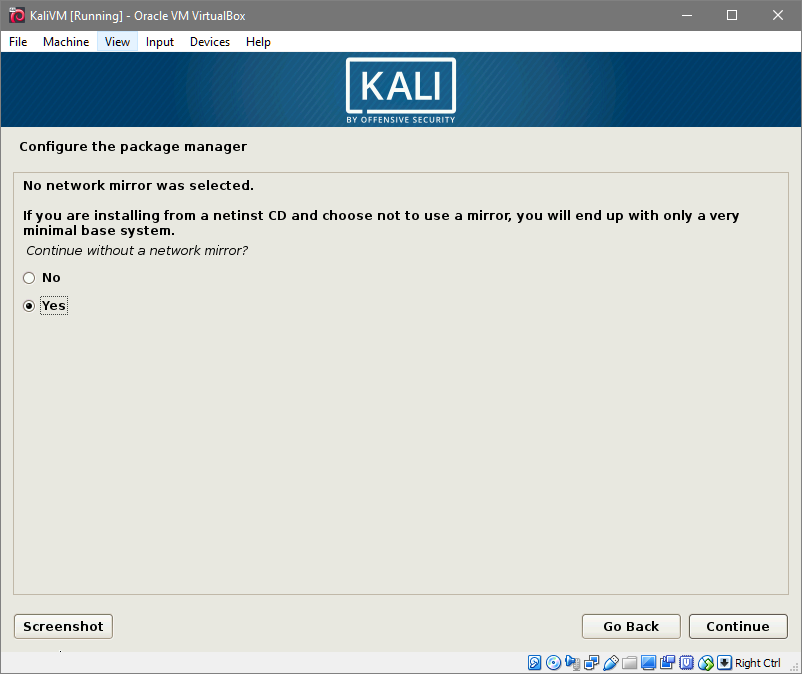If your System has primary OS Windows then you install your secondary OS Kali Linux. That will be ok, Kali Linux put boot entry of Window automatically for you. At initial boot menu you can see both OS entry to boot their those OS individually.
May be your window is corrupt in dual boot system or you want to install window as secondary OS after installing Kali Linux as primary OS. You may face corrupt boot-loader menu. You not able to boot Kali Linux any more because Window didn’t put entry of Kali Linux automatically in their boot menu.
Grub Installation Failed Kali Linux Install On Virtualbox

So this post motive is to help those guys which are facing those problems subjecting to corrupt Boot-loader. There are mainly two methods:
1. Repair Grub via Kali Linux live USB.
2. Repair Grub Via Boot-rapair-disk.
Method 1# Repair Grub via Kali Linux live USB
It is up to you which you want to choose but if you are Linux familiar then go for this method.
Requirements
This chapter covers how to install Kali Linux to a VM, or to a usb (for live boot purposes). Some important aspects this chapter covers, that may be missed by someone new are how to verify the integrity and authenticity of the ISO via sha256sum (very important for security purposes), as well as how to install Kali to a usb via the terminal. I tried installing Kali Linux with the exact instructions from this page. Most of the other guides have almost the same set of instructions when it comes to installing Kali on VirtualBox, but unfortunately I am getting errors while installing Kali with my Windows 10 version 1903. Aug 05, 2020 I tried installing Kali Linux with the exact instructions from this page. Most of the other guides have almost the same set of instructions when it comes to installing Kali on VirtualBox, but unfortunately I am getting errors while installing Kali with my Windows 10 version 1903.
1. A Kali Linux ISO image. You can download here:
2. You need to create a Kali Linux pre-installed live CD or Live USB. You can click following link for more help to create live USB or CD-DVD.
Procedure to repair Grub of Kali Linux
Step 1. Boot your live USB via pressing boot menu button on initial stage of booting your system. Select “Live” option.
Step 2. Boot into Live Kali Linux, get the Terminal open. Type the following commands:
Grub Installation Failed Kali Linux Install On Virtualbox 7
mount /dev/sda3 /mnt
mount –bind /dev /mnt/dev
mount –bind /dev/pts /mnt/dev/pts
mount –bind /proc /mnt/proc
mount –bind /sys /mnt/sys
chroot /mnt
grub-install /dev/sda
update-grub
exit
umount /mnt/dev/pts
umount /mnt/dev
umount /mnt/proc
umount /mnt/sys
umount /mnt
Step 3. Now reboot the system, you will see your boot-menu showing Window and Kali Linux both simultaneously.
Most of the time Kali Linux grub is repaired by above steps but exceptionally you may not, so you have to do more commanding.
Step 4. Boot the Live Kali Linux again, open the terminal type the following commands:
apt-get install os-prober
os-prober
update-grub
This will help a lot to repair Kali Linux Grub. Good-luck!
Method 2# Repair Grub Via Boot-rapair-disk
Grub Installation Failed Kali Linux Install On Virtualbox 10
It is up to you which you want to choose but if you are not Linux familiar then go for this method.

Requirements
1. A Boot-repair-disk ISO image. You can download here:
2. You need to create a Boot-repair-disk pre-installed in live CD or Live USB. You can click following link for more help to create live USB or CD-DVD.
Procedure to repair Kali Linux Grub
Boot into Live USB by pressong boot-button at initial stage of booting the system.
After that, it is all automated. As soon as you boot into this live disk, it will automatically begin mounting all your file systems and looking for grub. Once it is located, it will be restored automatically and at the end a message will be displayed to you.
Kali Linux
So if you are someone who isn’t all that thrilled about typing commands on a Linux terminal in the method I discussed previously, this ISO is for you.